Impact of Subsidy Programmes on the Development of the Number and Output of RES Micro-Installations in Poland
Abstract
1. Introduction
Hypothesis and the Research Objective
2. The Renewable Energy in Poland
3. Methods
4. Data Analysis
- The launch of the “My Electricity” programme did not cause a significant increase in the number and output of micro-installations at the threshold, i.e., in 2019Q4 (lack of statistical significance of the parameter at variable D). This fact is justified by the fact that the installation of photovoltaic panels is an investment that takes more than one quarter to complete. The increase in the number and output of installed micro-installations will be visible more than a quarter after the introduction of the new legislation.
- Both models, (12) and (14), have significant slope parameters. Positive signs of estimators of indicate that before 2019Q4 the number and output of micro-installations increased. However, the lack of significance of these parameters informs the fact that this growth was slow from quarter to quarter.
- The estimators of the parameter were statistically significant and positive for both models. Comparing the slope parameters in models (12) and (13), as well as (14) and (15), one can see a clear sharp increase in their values. This means that since 2019Q4 the number and output of micro-installations started to increase rapidly.
5. Discussion
6. Conclusions
Funding
Data Availability Statement
Conflicts of Interest
References
- Energy for the Future: Renewable Sources of Energy—White Paper for a Community Strategy and Action Plan, COM(97)599 Final (26/11/1997). Available online: http://europa.eu.int/comm/energy/library/599fi_en.pdf (accessed on 25 October 2022).
- Jäger-Waldau, A.; Scholz, H. EU renewables: Energy end-use efficiency and electricity from biomass, wind and PV in the EU. Refocus 2005, 6, 58–60. [Google Scholar] [CrossRef]
- European Commission Communication. The European Green Deal; COM (2019) 640 Final; European Commission: Brussels, Belgium, 2019; Available online: https://ec.europa.eu/info/publications/communication-european-green-deal_en (accessed on 23 October 2022).
- Jäger-Waldau, A. The Untapped Area Potential for Photovoltaic Power in the European Union. Clean Technol. 2020, 2, 440–446. [Google Scholar] [CrossRef]
- Jonek-Kowalska, I. Assessing the energy security of European countries in the resource and economic context. Oecon. Copernic. 2022, 13, 301–334. [Google Scholar] [CrossRef]
- Jonek-Kowalska, I. Transformation of energy balances with dominant coal consumption in European economies and Turkey in the years 1990–2017. Oecon. Copernic. 2019, 10, 627–647. [Google Scholar] [CrossRef]
- GUS. Energy 2022. Warszawa 2022. Available online: https://stat.gov.pl/obszary-tematyczne/srodowisko-energia/energia/energia-2022,1,10.html (accessed on 2 November 2022).
- Pietruszko, S.M. Photovoltaics in Poland. Appl. Energy 2003, 74, 169–175. [Google Scholar] [CrossRef]
- Jurasz, J.K.; Dąbek, P.B.; Campana, P.E. Can a city reach energy self-sufficiency by means of rooftop photovoltaics? Case study from Poland. J. Clean. Prod. 2020, 245, 118813. [Google Scholar] [CrossRef]
- Mikroinstalacje w Polsce. Available online: http://www.ptpiree.pl/energetyka-w-polsce/energetyka-w-liczbach/mikroinstalacje-w-polsce (accessed on 10 October 2022).
- Rynska, E. Review of PV Solar Energy Development 2011–2021 in Central European Countries. Energies 2022, 15, 8307. [Google Scholar] [CrossRef]
- Thistlethwaite, D.L.; Campbell, D.T. Regression Discontinuity Analysis: An Alternative to ex post facto Experiment. J. Educ. Psychol. 1960, 51, 309–317. [Google Scholar] [CrossRef]
- Cook, T.D. “Waiting for Life to Arrive”: A history of the regression-discontinuity design in Psychology, Statistics and Economics. J. Econom. 2008, 142, 636–654. [Google Scholar] [CrossRef]
- Lee, D.S.; Lemieux, T. Regression Discontinuity Designs in Economics. J. Econ. Lit. 2010, 48, 281–355. [Google Scholar] [CrossRef]
- Lalive, R. Unemployment Benefits, Unemployment Duration, and Post-Unemployment Jobs: A Regression Discontinuity Approach. Am. Econ. Rev. 2007, 97, 108–112. [Google Scholar] [CrossRef]
- Lee, H.; Munk, T. Using regression discontinuity design for program evaluation. In Proceedings of the 2008 Joint Statistical Meeting, Denver, CO, USA, 3–7 August 2008; American Statistical Association: Alexandria, VA, USA, 2008; pp. 3–7. Available online: http://www.amstat.org/sections/srms/proceedings/y2008/Files/301149.pdf (accessed on 1 October 2022).
- Brügger, B.; Lalive, R.; Zweimüller, J. Does Culture Affect Unemployment? Evidence from the Röstigraben, IZA Discussion Papers 428, 2009. Available online: https://www.iza.org/publications/dp/4283/does-culture-affect-unemployment-evidence-from-the-rostigraben (accessed on 25 October 2022).
- Schmieder, J.F.; von Wachter, T.; Bender, S. The Effects of Extended Unemployment Insurance Over the Business Cycle: Evidence from Regression Discontinuity Estimates Over 20 Years. Q. J. Econ. 2012, 127, 701–752. [Google Scholar] [CrossRef]
- Decramer, S.; Vanormelingen, S. The effectiveness of investment subsidies: Evidence from a regression discontinuity design. Small Bus. Econ. 2016, 47, 1007–1032. [Google Scholar] [CrossRef]
- Markowicz, I.; Bieszk-Stolorz, B. The Application of Survival Analysis to Evaluating the Efficiency of a Professional Effectiveness Enhancement Programme. Acta Univ. Lodziensis. Folia Oeconomica 2016, 1, 85–91. [Google Scholar] [CrossRef][Green Version]
- Cadil, J.; Mirosnik, K.; Petkovova, L.; Mirvald, M. Public Support of Private R&D—Effects on Economic Sustainability. Sustainability 2018, 10, 4612. [Google Scholar] [CrossRef]
- Cansino, J.M.; Sánchez-Braza, A.; Espinoza, N. Evaluating the Impact of an Active Labour Market Policy on Employment: Short- and Long-Term Perspectives. Soc. Sci. 2018, 7, 58. [Google Scholar] [CrossRef]
- Wang, S.; Li, Y.; Haque, M. Evidence on the Impact of Winter Heating Policy on Air Pollution and Its Dynamic Changes in North China. Sustainability 2019, 11, 2728. [Google Scholar] [CrossRef]
- Wang, X.; Chen, C.; Du, Y.; Zhang, Y.; Wu, C. Analysis of Policies Based on the Multi-Fuzzy Regression Discontinuity, in Terms of the Number of Deaths in the Coronavirus Epidemic. Healthcare 2021, 9, 116. [Google Scholar] [CrossRef]
- Lotsu, S.; Yoshida, Y.; Fukuda, K.; He, B. Effectiveness of a Power Factor Correction Policy in Improving the Energy Efficiency of Large-Scale Electricity Users in Ghana. Energies 2019, 12, 2582. [Google Scholar] [CrossRef]
- Dong, D.; Xu, X.; Wong, Y.F. Estimating the Impact of Air Pollution on Inbound Tourism in China: An Analysis Based on Regression Discontinuity Design. Sustainability 2019, 11, 1682. [Google Scholar] [CrossRef]
- Ogunmodede, A.M.; Ogunsanwo, M.O.; Manyong, V. Unlocking the Potential of Agribusiness in Africa through Youth Participation: An Impact Evaluation of N-Power Agro Empowerment Program in Nigeria. Sustainability 2020, 12, 5737. [Google Scholar] [CrossRef]
- Bieszk-Stolorz, B.; Dmytrów, K. Impact of Changes to Procedures on the Evaluation of the Effectiveness of Forms of Professional Activation in Poland. Economies 2021, 9, 88. [Google Scholar] [CrossRef]
- Zhao, X.; Cheng, Z.; Jiang, C. Could Air Quality Get Better during Epidemic Prevention and Control in China? An Analysis Based on Regression Discontinuity Design. Land 2021, 10, 373. [Google Scholar] [CrossRef]
- Dmytrów, K.; Landmesser, J.; Bieszk-Stolorz, B. The Connections between COVID-19 and the Energy Commodities Prices: Evidence through the Dynamic Time Warping Method. Energies 2021, 14, 4024. [Google Scholar] [CrossRef]
- Serowaniec, M. Sustainable Development Policy and Renewable Energy in Poland. Energies 2021, 14, 2244. [Google Scholar] [CrossRef]
- Pietrzak, M.B.; Igliński, B.; Kujawski, W.; Iwański, P. Energy Transition in Poland—Assessment of the Renewable Energy Sector. Energies 2021, 14, 2046. [Google Scholar] [CrossRef]
- Iglinski, B.; Flisikowski, K.; Pietrzak, M.B.; Kiełkowska, U.; Skrzatek, M.; Zyadin, A.; Natarajan, K. Renewable Energy in the Pomerania Voivodeship—Institutional, Economic, Environmental and Physical Aspects in Light of EU Energy Transformation. Energies 2021, 14, 8221. [Google Scholar] [CrossRef]
- Jankowska, B.; Staliński, A.; Trąpczyński, P. Public policy support and the competitiveness of the renewable energy sector–The case of Poland. Renew. Sust. Energ. Rev. 2021, 149, 111235. [Google Scholar] [CrossRef]
- Pietrzak, M.B.; Olczyk, M.; Kuc-Czarnecka, M.E. Assessment of the Feasibility of Energy Transformation Processes in European Union Member States. Energies 2022, 15, 661. [Google Scholar] [CrossRef]
- Olczak, P.; Jaśko, P.; Kryzia, D.; Matuszewska, D.; Fyk, M.I.; Dyczko, A. Analyses of duck curve phenomena potential in polish PV prosumer households’ installations. Energy Rep. 2021, 7, 4609–4622. [Google Scholar] [CrossRef]
- Nyasha, S.; Odhiambo, N. The Impact of Public Expenditure on Economic Growth: A Review of International Literature. Folia Oeconomica Stetin. 2019, 19, 81–101. [Google Scholar] [CrossRef]
- Gnatowska, R.; Moryń-Kucharczyk, E. The Place of Photovoltaics in Poland’s Energy Mix. Energies 2021, 14, 1471. [Google Scholar] [CrossRef]
- Wilkinson, S.; John, M.; Morrison, G.M. Rooftop PV and the Renewable Energy Transition; a Review of Driving Forces and Analytical Frameworks. Sustainability 2021, 13, 5613. [Google Scholar] [CrossRef]
- Czarnecka, M.; Chudy–Laskowska, K.; Kinelski, G.; Lew, G.; Sadowska, B.; Wójcik-Jurkiewicz, M.; Budka, B. Grants and Funding for the Processes of Decarbonization in the Scope of Sustainability Development—The Case from Poland. Energies 2022, 15, 7481. [Google Scholar] [CrossRef]
- Wuebben, D.; Peters, J.F. Communicating the Values and Benefits of Home Solar Prosumerism. Energies 2022, 15, 596. [Google Scholar] [CrossRef]
- Mir-Artigues, P.; Cerdá, E.; del Río, P. Analyzing the Impact of Cost-Containment Mechanisms on the Profitability of Solar PV Plants in Spain. Renew. Sustain. Energy Rev. 2015, 46, 166–177. [Google Scholar] [CrossRef]
- Christoforidis, G.C.; Panapakidis, I.P.; Papadopoulos, T.A.; Papagiannis, G.K.; Koumparou, I.; Hadjipanayi, M.; Georghiou, G.E. A Model for the Assessment of Different Net-Metering Policies. Energies 2016, 9, 262. [Google Scholar] [CrossRef]
- Trochim, W. Research Design for Program Evaluation: The Regression-Discontinuity Approach; Sage Publications: Beverly Hills, LA, USA, 1984. [Google Scholar]
- Hahn, J.; Todd, P.; Van der Klaauw, W. Identification and Estimation of Treatment Effects with a Regression-Discontinuity Design. Econometrica 2001, 69, 201–209. [Google Scholar] [CrossRef]
- ARE. Available online: https://www.are.waw.pl/ (accessed on 14 October 2022).
- PTPiREE. Available online: http://ptpiree.pl/ (accessed on 14 October 2022).
- Kata, R.; Cyran, K.; Dybka, S.; Lechwar, M.; Pitera, R. The Role of Local Government in Implementing Renewable Energy Sources in Households (Podkarpacie Case Study). Energies 2022, 15, 3163. [Google Scholar] [CrossRef]
- Zdonek, I.; Tokarski, S.; Mularczyk, A.; Turek, M. Evaluation of the Program Subsidizing Prosumer Photovoltaic Sources in Poland. Energies 2022, 15, 846. [Google Scholar] [CrossRef]
- Kulpa, J.; Olczak, P.; Surma, T.; Matuszewska, D. Comparison of Support Programs for the Development of Photovoltaics in Poland: My Electricity Program and the RES Auction System. Energies 2022, 15, 121. [Google Scholar] [CrossRef]
- Maciaszczyk, M.; Czechowska-Kosacka, A.; Rzepka, A.; Lipecki, T.; Łazuka, E.; Wlaź, P. Consumer Awareness of Renewable Energy Sources: The Case of Poland. Energies 2022, 15, 8395. [Google Scholar] [CrossRef]
- Pietrzak, M.B.; Kuc-Czarnecka, M. Transformation of Energy Markets: Description, Modeling of Functioning Mechanisms and Determining Development Trends. Energies 2022, 15, 5493. [Google Scholar] [CrossRef]
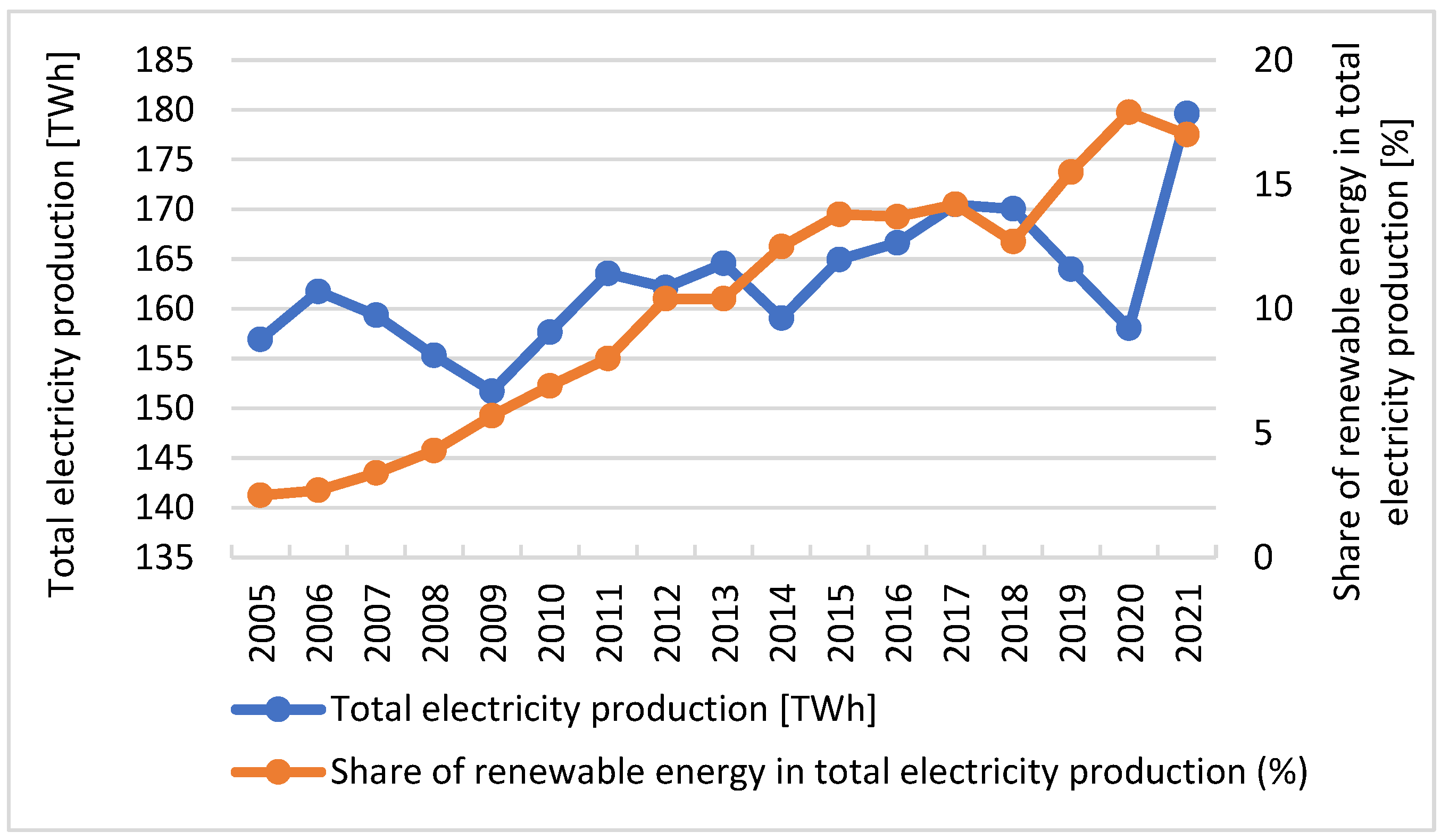
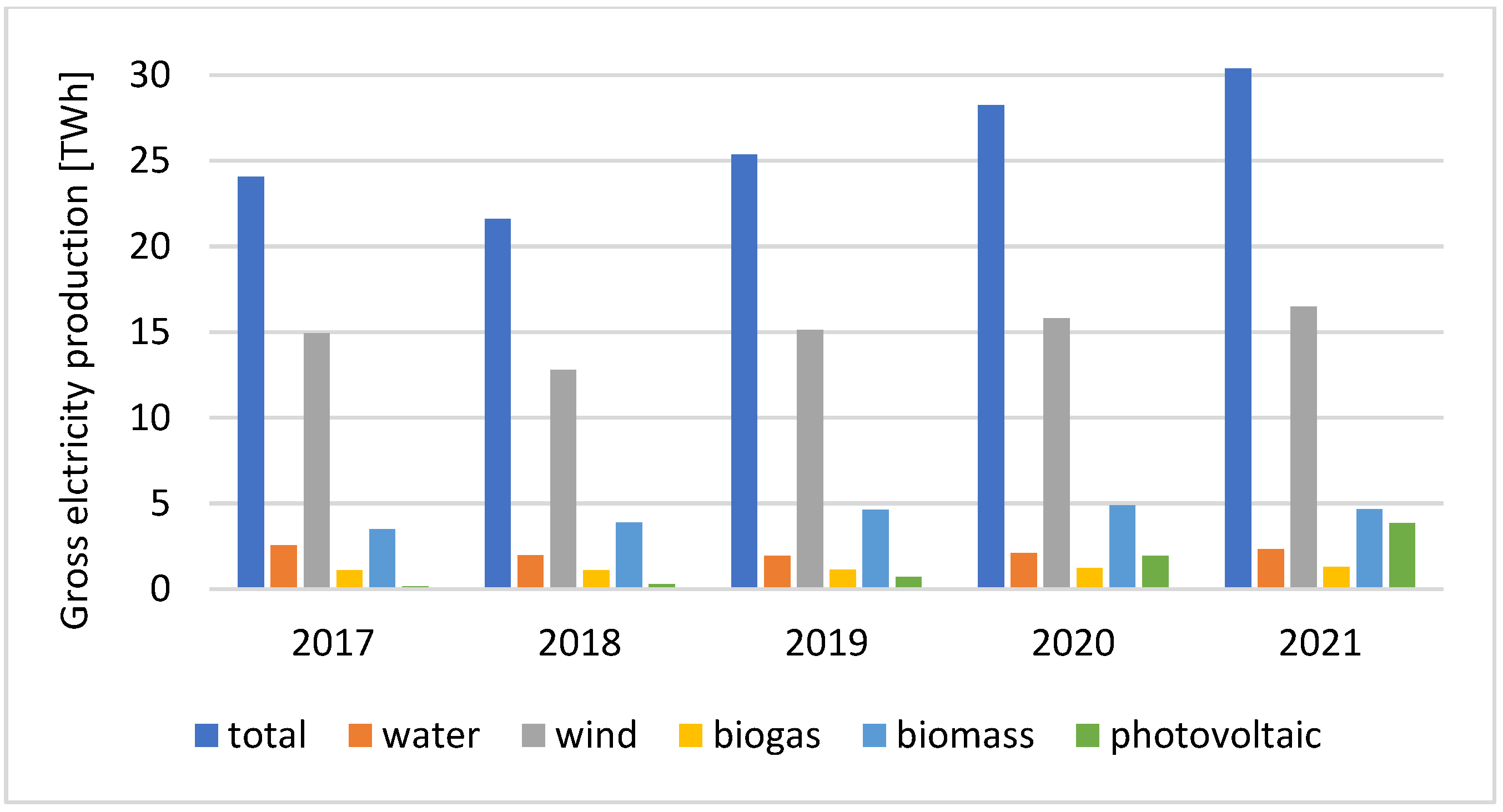
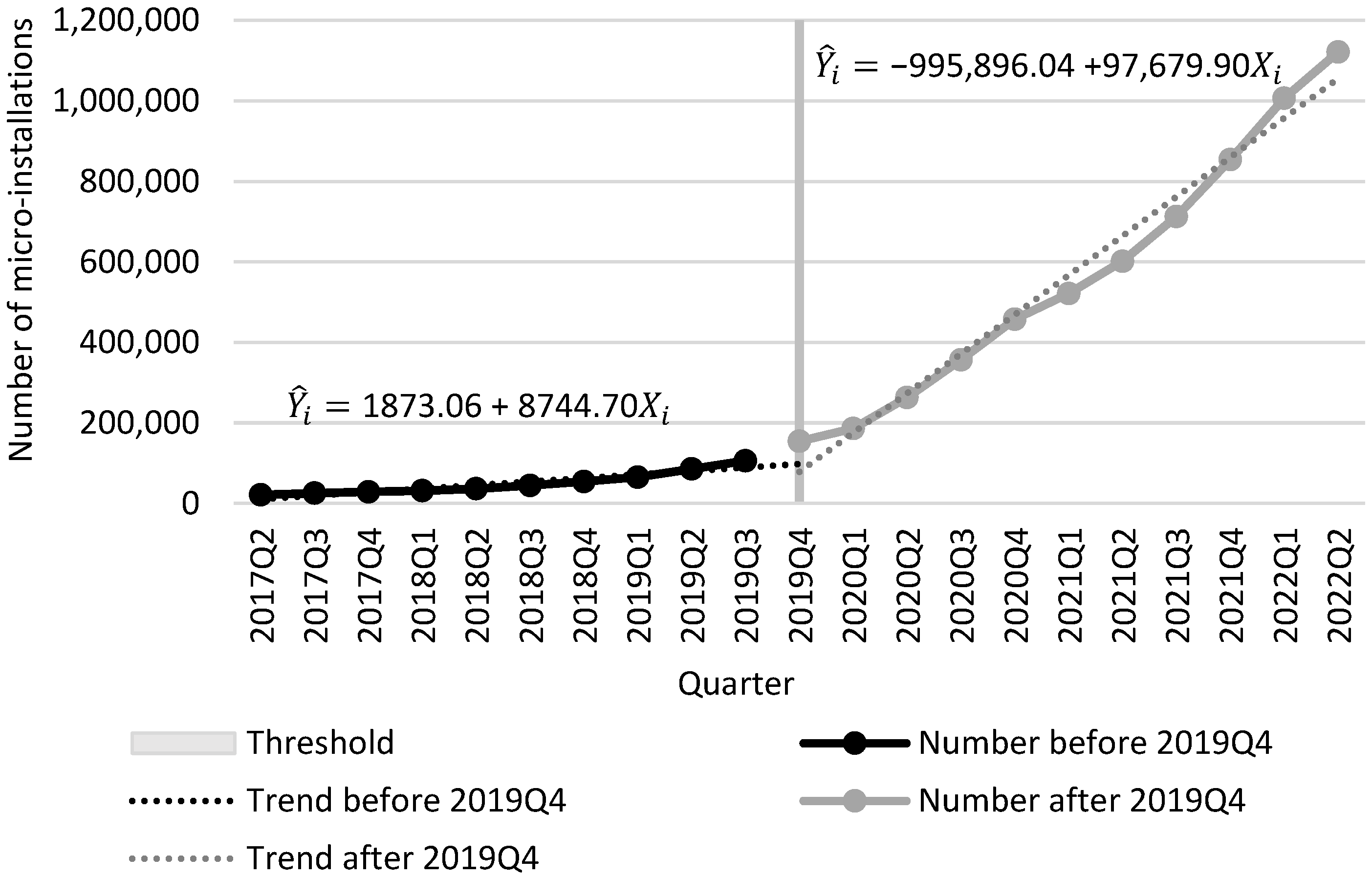
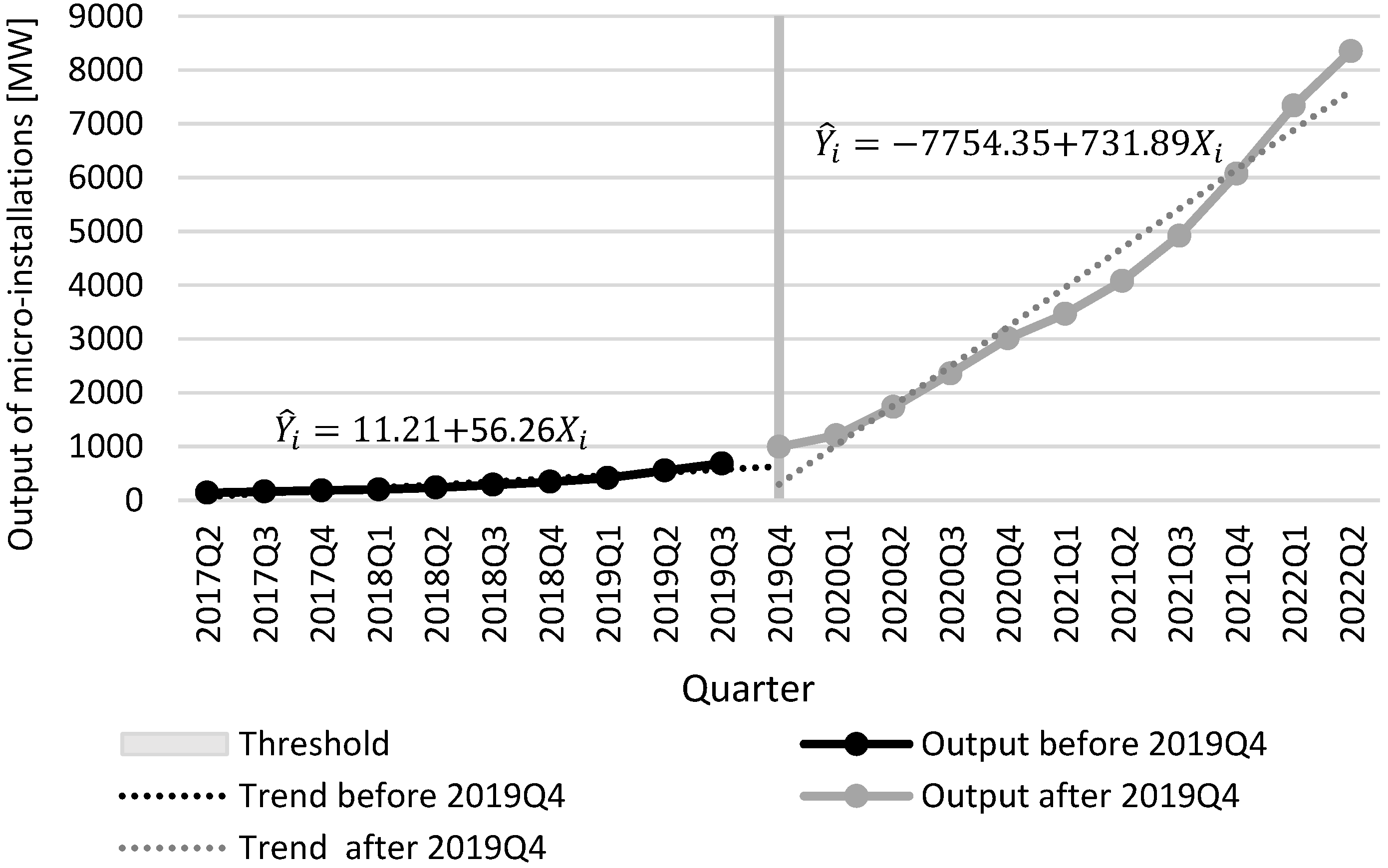
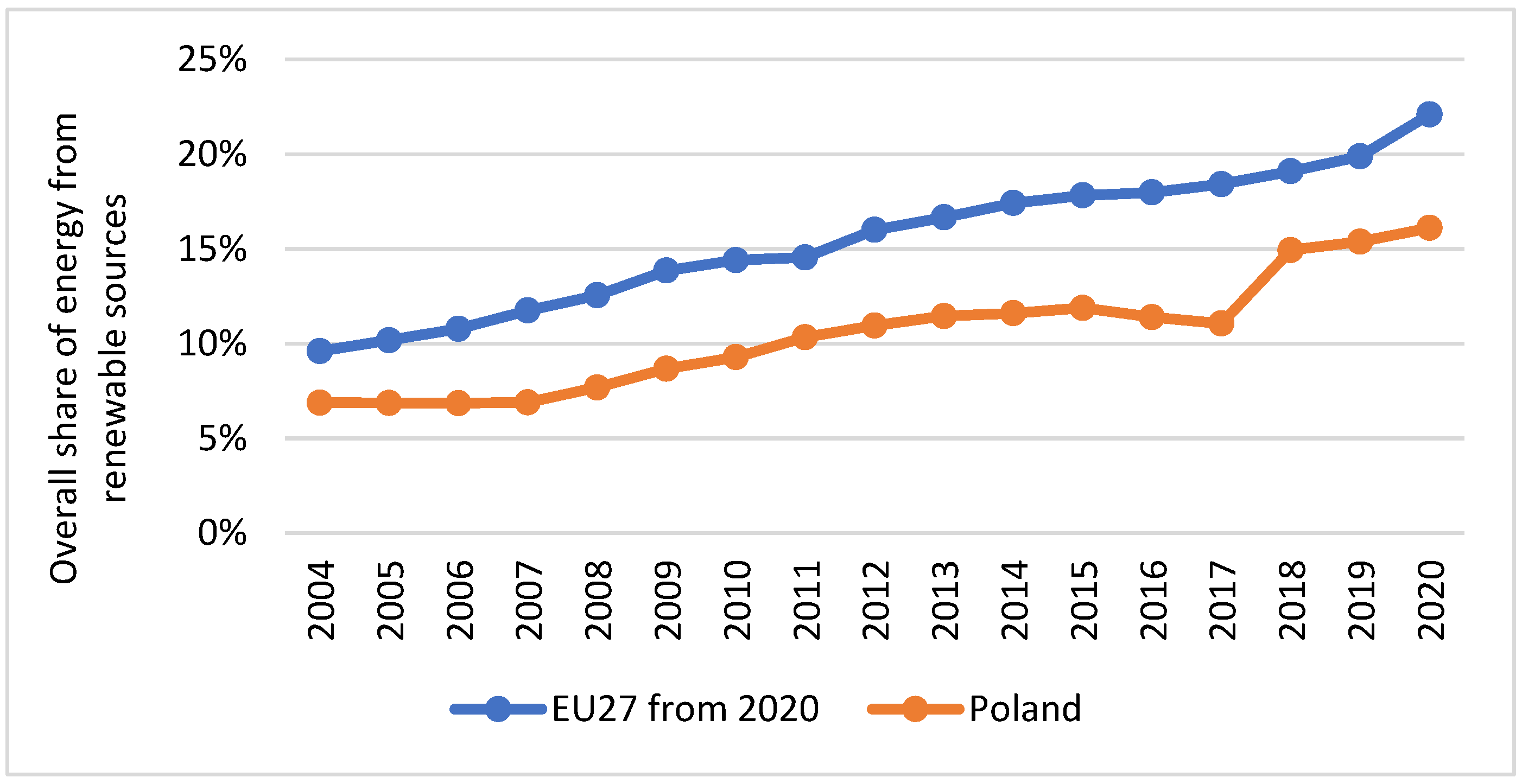
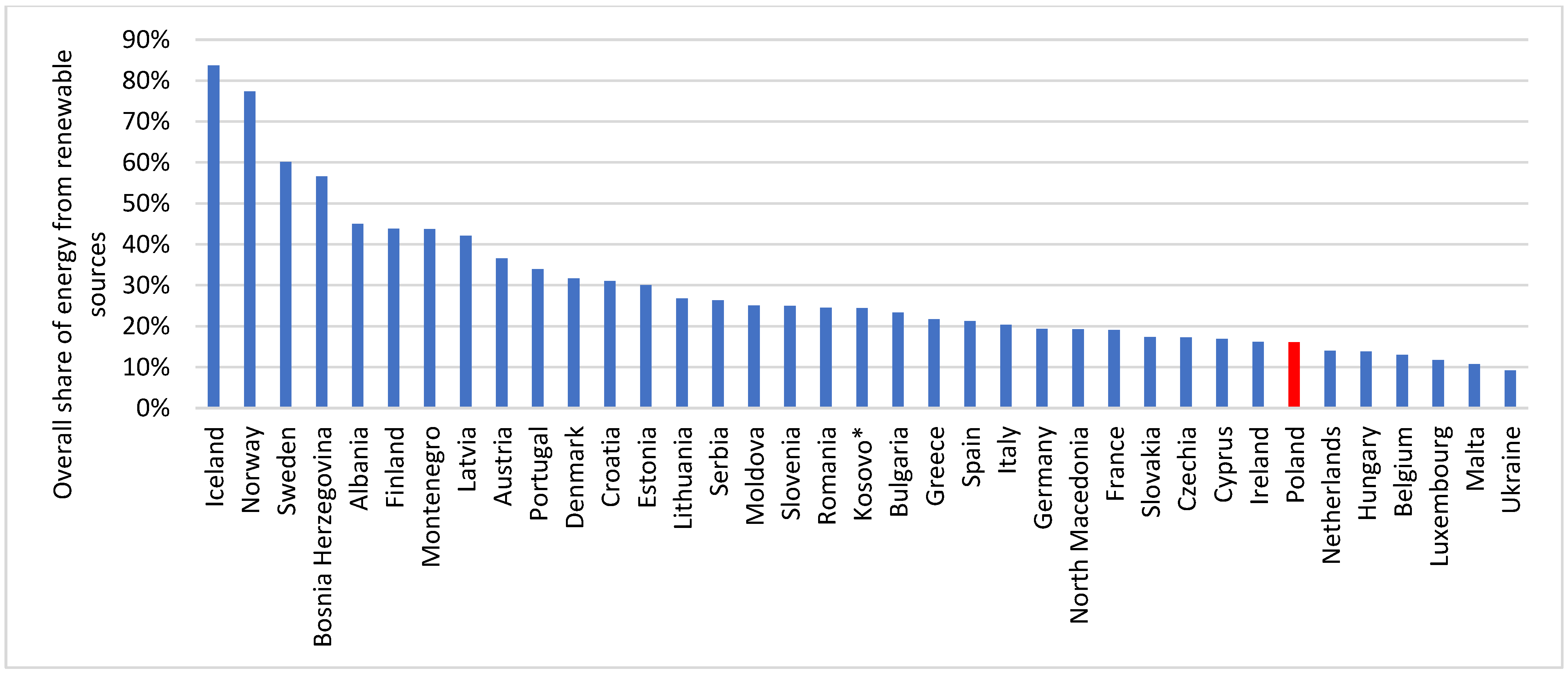
| Energy Sources (Electricity) | ||||||
|---|---|---|---|---|---|---|
| Years | Total | Water | Wind | Photovoltaic | Hybrid RES Installations | Biogas |
| 2017 | 25,623 | 3 | 19 | 25,571 | 28 | 2 |
| 2018 | 51,016 | 8 | 54 | 50,933 | 18 | 3 |
| 2019 | 144,940 | 8 | 56 | 144,856 | 17 | 3 |
| 2020 | 435,455 | 18 | 67 | 435,314 | 29 | 10 |
| 2021 | 845,505 | 75 | 70 | 845,259 | 45 | 33 |
| Parameter | Parameter’s Estimator | Standard Error | p-Value | Parameter’s Estimator | Standard Error | p-Value |
|---|---|---|---|---|---|---|
| Number of Micro-Installations R2 = 0.9910 | Output of Micro-Installations R2 = 0.9829 | |||||
| 98,064.73 | 24,782.23 | 0.0010 | 630.03 | 247.61 | 0.0209 | |
| −19,481.87 | 32,138.82 | 0.5524 | −333.64 | 321.12 | 0.3134 | |
| 8744.70 | 3994.02 | 0.0428 | 56.26 | 39.91 | 0.1767 | |
| 88,935.20 | 5283.60 | 0.0000 | 675.63 | 52.79 | 0.0000 | |
| Countries | Electricity | |||||
|---|---|---|---|---|---|---|
| RES % | Hydro % | Wind % | Solar % | Solid Biofuels % | All Other Renewables % | |
| Norway | 113.8 | 93.8 | 6.0 | 0.0 | 0.0 | 0.1 |
| Iceland | 102.7 | 69.6 | 0.0 | 0.0 | 0.0 | 30.3 |
| Albania | 100.0 | 99.6 | 0.0 | 0.4 | 0.0 | 0.0 |
| Austria | 78.2 | 75.6 | 12.5 | 3.7 | 6.5 | 1.7 |
| Sweden | 74.5 | 64.4 | 23.7 | 1.0 | 9.2 | 1.6 |
| Denmark | 65.3 | 0.1 | 68.6 | 5.1 | 18.5 | 7.7 |
| Montenegro | 61.5 | 85.2 | 14.7 | 0.1 | 0.0 | 0.0 |
| Portugal | 58.0 | 40.0 | 41.5 | 5.5 | 10.4 | 2.6 |
| Croatia | 53.8 | 70.4 | 17.5 | 1.0 | 5.8 | 5.3 |
| Latvia | 53.4 | 74.0 | 3.9 | 0.1 | 13.3 | 8.8 |
| Bosnia & Herzegovina | 49.3 | 94.2 | 4.8 | 0.7 | 0.1 | 0.1 |
| Germany | 44.7 | 8.2 | 50.6 | 20.0 | 4.6 | 16.5 |
| Romania | 43.4 | 63.9 | 27.0 | 6.9 | 2.0 | 0.2 |
| Spain | 42.9 | 26.8 | 49.8 | 18.0 | 4.0 | 1.4 |
| Finland | 39.6 | 43.6 | 20.9 | 0.7 | 32.4 | 2.5 |
| Ireland | 39.1 | 6.1 | 85.8 | 0.5 | 3.5 | 4.1 |
| Italy | 38.1 | 40.5 | 16.8 | 21.1 | 3.8 | 17.8 |
| Greece | 35.9 | 27.5 | 47.4 | 23.3 | 0.1 | 1.7 |
| Slovenia | 35.1 | 87.7 | 0.1 | 7.0 | 3.0 | 2.2 |
| Serbia | 30.7 | 89.5 | 8.6 | 0.1 | 0.2 | 1.5 |
| Estonia | 28.3 | 1.3 | 26.1 | 4.5 | 64.3 | 3.9 |
| The Netherlands | 26.4 | 0.3 | 43.7 | 27.5 | 18.1 | 10.4 |
| Belgium | 25.1 | 1.4 | 51.7 | 23.1 | 15.0 | 8.9 |
| France | 24.8 | 50.7 | 30.1 | 11.2 | 3.3 | 4.7 |
| Bulgaria | 23.6 | 47.2 | 16.3 | 17.0 | 16.9 | 2.6 |
| North Macedonia | 23.5 | 89.6 | 5.9 | 1.3 | 0.0 | 3.2 |
| Slovakia | 23.1 | 64.8 | 0.1 | 10.0 | 16.8 | 8.3 |
| Lithuania | 20.2 | 17.1 | 54.6 | 5.1 | 14.6 | 8.7 |
| Poland | 16.2 | 8.4 | 54.4 | 7.1 | 25.0 | 5.1 |
| Czechia | 14.8 | 21.2 | 6.5 | 22.0 | 24.1 | 26.2 |
| Ukraine | 13.9 | 51.6 | 15.0 | 29.7 | 1.4 | 2.3 |
| Luxembourg | 13.9 | 11.2 | 31.3 | 17.3 | 28.6 | 11.6 |
| Cyprus | 12.0 | 0.0 | 39.0 | 50.6 | 0.0 | 10.4 |
| Hungary | 11.9 | 4.3 | 12.2 | 44.3 | 30.0 | 9.2 |
| Malta | 9.5 | 0.0 | 0.0 | 97.5 | 0.0 | 2.4 |
| Kosovo | 5.3 | 79.2 | 17.7 | 3.1 | 0.0 | 0.0 |
| Moldova | 3.1 | 41.0 | 34.9 | 2.9 | 0.0 | 21.1 |
Publisher’s Note: MDPI stays neutral with regard to jurisdictional claims in published maps and institutional affiliations. |
© 2022 by the author. Licensee MDPI, Basel, Switzerland. This article is an open access article distributed under the terms and conditions of the Creative Commons Attribution (CC BY) license (https://creativecommons.org/licenses/by/4.0/).
Share and Cite
Bieszk-Stolorz, B. Impact of Subsidy Programmes on the Development of the Number and Output of RES Micro-Installations in Poland. Energies 2022, 15, 9357. https://doi.org/10.3390/en15249357
Bieszk-Stolorz B. Impact of Subsidy Programmes on the Development of the Number and Output of RES Micro-Installations in Poland. Energies. 2022; 15(24):9357. https://doi.org/10.3390/en15249357
Chicago/Turabian StyleBieszk-Stolorz, Beata. 2022. "Impact of Subsidy Programmes on the Development of the Number and Output of RES Micro-Installations in Poland" Energies 15, no. 24: 9357. https://doi.org/10.3390/en15249357
APA StyleBieszk-Stolorz, B. (2022). Impact of Subsidy Programmes on the Development of the Number and Output of RES Micro-Installations in Poland. Energies, 15(24), 9357. https://doi.org/10.3390/en15249357







